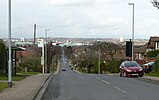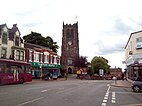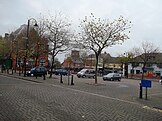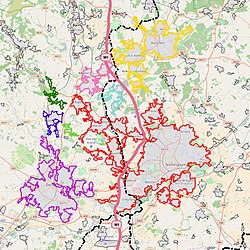
The Nottingham Built-up Area (BUA), Nottingham Urban Area, or Greater Nottingham is an area of land defined by the Office for National Statistics as built-up land with a minimum area of 20 hectares (200,000 m), while settlements within 200 metres of each other are linked. It consists of the city of Nottingham and the adjoining urban areas of Nottinghamshire and Derbyshire, in the East Midlands of England. It had a total population of 729,977 at the time of the 2011 census. This was an increase of almost 10% since the 2001 census recorded population of 666,358, due to population increases, reductions and several new sub-divisions.
Geography
Notable Settlements of Nottingham Urban Area








 Notable settlements of Nottingham Urban Area
Notable settlements of Nottingham Urban Area
Landmarks from top left to bottom right:
- Nottingham City Skyline
- Town Hall, Beeston
- Musters Road, West Bridgford
- St Mary's Church, Ilkeston
- Arnold Town Centre
- St Lawrence's Church, Heanor
- St Mary's Church, Clifton
- Market Square, Ripley
- Rows of housing in Long Eaton
- St Peter's Church, Ruddington
Greater Nottingham is largely within the three districts of Rushcliffe, Broxtowe and Gedling surrounding the city, though the area spills into the Nottinghamshire district of Ashfield, and also to the Amber Valley and Erewash districts of Derbyshire. The Nottingham Urban Area is, by the ONS' figures, the 8th largest in England (9th in the UK), with a population size between that of the Tyneside and Sheffield built-up areas, and a total area of 68.1 square miles (176 km).
The Nottingham Urban Area is bounded to the west by a narrow gap between Draycott (to the west of the Breaston urban area sub-division) and Borrowash (to the east of the Derby Urban Area). The Heanor/Ripley and West Hallam north-western extensions have a somewhat tenuous linkage through to the core of Nottingham City largely due to ribbon development, and are in close proximity to other nearby urban areas which together, almost link to Derby from the north.
Sub-divisions do not always match administrative geographic boundaries; the subdivision of Clifton for example is within the Nottingham Unitary Authority city area but is subdivided by the River Trent. The Nottingham subdivision oversteps the city's borders at several locations. Together, these two subdivisions exceed the official city population (305,680 in 2011) as a result, even though West Bridgford includes the counts of city suburbs Silverdale and Wilford.
In the 1991 census, Ilkeston was considered outside of the Nottingham Urban Area, and its addition gave the BUA an 8% increase in 2001. This was due to improvements in mapping methodology by the ONS, and is chiefly responsible for the increase in sub-divisions over censuses rather than any large scale 'bricks and mortar' building, as much of the area between the cities is protected green belt and wedges, restricting actual development.
| Urban subdivision | Population | District | County | |||
|---|---|---|---|---|---|---|
| 1981 census | 1991 census | 2001 census | 2011 census | |||
| Nottingham | 273,300 | 270,222 | 249,584 | 289,301 | City of Nottingham | Nottinghamshire |
| Beeston | 64,785 | 66,626 | 66,683 | 51,479 | Broxtowe | Nottinghamshire |
| Carlton | 46,053 | 47,302 | 48,493 | 49,235 | Gedling | Nottinghamshire |
| West Bridgford | 27,463 | 33,843 | 43,395 | 45,509 | Rushcliffe | Nottinghamshire |
| Ilkeston | — | — | 37,270 | 38,640 | Erewash | Derbyshire |
| Arnold | 37,721 | 37,646 | 37,402 | 37,768 | Gedling | Nottinghamshire |
| Long Eaton | 42,285 | 44,826 | 46,490 | 37,760 | Erewash | Derbyshire |
| Hucknall | 27,463 | 29,160 | 29,188 | 32,107 | Ashfield | Nottinghamshire |
| Heanor | 21,863 | 22,180 | 22,620 | 25,644 | Amber Valley | Derbyshire |
| Clifton | — | — | 22,312 | 22,407 | City of Nottingham | Nottinghamshire |
| Ripley | 17,548 | 18,310 | 18,523 | 19,315 | Amber Valley | Derbyshire |
| Eastwood | 18,085 | 19,363 | 18,612 | 18,422 | Broxtowe | Nottinghamshire |
| Stapleford | — | — | — | 16,190 | Broxtowe | Nottinghamshire |
| Kimberley | 9,818 | 10,488 | 11,027 | 11,353 | Broxtowe | Nottinghamshire |
| Sandiacre | — | — | — | 9,600 | Erewash | Derbyshire |
| Breaston | — | 7,284 | 7,305 | 7,545 | Erewash | Derbyshire |
| Ruddington | 6,504 | 6,476 | 6,264 | 7,020 | Rushcliffe | Nottinghamshire |
| West Hallam | — | — | — | 6,016 | Erewash | Derbyshire |
| Awsworth | — | — | — | 2,517 | Broxtowe | Nottinghamshire |
| Trowell | — | — | 1,013 | 953 | Broxtowe | Nottinghamshire |
| Stanton-By-Dale | — | — | — | 505 | Erewash | Derbyshire |
| Denby Common | — | — | — | 495 | Amber Valley | Derbyshire |
| Ruddington Grange | — | — | 177 | 196 | Rushcliffe | Nottinghamshire |
| Total | 593,768 | 613,726 | 666,358 | 729,977 | ||
| Change | - | +3.36% | +8.58% | +9.55% | ||
- Awsworth, Breaston, Denby Common, Ilkeston, Ruddington Grange and West Hallam were independent areas until their inclusion in the table.
- Total of 1981 subdivision figures is 592,888, an additional 880 residents are unaccounted for in the census report total.
- Up to the 2001 census, the Beeston subdivision included Stapleford and was named Beeston And Stapleford.
- Up to the 2001 census, Sandiacre was included as part of the Long Eaton subdivision.
- Up to the 1991 census, the Nottingham subdivision included Clifton.
- In the 2001 census, Stanton-By-Dale was included as part of the Ilkeston subdivision.
Greater Nottingham Partnership/D2N2
The local authorities collaborate in some ways. The Greater Nottingham Partnership considered Greater Nottingham to consist of the City of Nottingham plus the entirety of the Rushcliffe, Broxtowe and Gedling boroughs, along with Hucknall from Ashfield, but no part of Derbyshire, as no Derbyshire council was a member of the Partnership. They together worked as an advisory and lobbying body for projects and decisions involving the region. However it was axed due to funding in 2011 and the D2N2 Local Enterprise Partnership is instead assuming those functions with cross-county political and local business support.
Nottingham-Derby metropolitan area

The conurbation forms a large part of the Nottingham-Derby metropolitan area, which has an estimated population of 1.5 million. The urban areas of both Derby and Nottingham are almost continuous with Draycott (part of the Breaston Urban sub-division) being almost continuous with the Borrowash part of the Derby Urban Area. The Mansfield Urban Area also forms part of this metropolitan area, although it is not continuous with the Nottingham Urban Area. However, it is almost continuous with the Alfreton/South Normanton Built-up area, which had a population of 41,289 according to the last census, with the South Normanton/Pinxton Urban sub-division of the Alfreton Urban Area being almost continuous with the Sutton-in-Ashfield Urban sub-division of the Mansfield Urban Area. The Alfreton Urban Area is also nearly continuous with Ripley part of the Nottingham Urban Area. Other minor urban areas to the west of the Ripley, Heanor and West Hallam sub divisions daisy-chain towards Derby from the north, notably Belper, Kilburn and Crich/Heage. See the maps above for a demonstration of these BUAs in close proximity.
See also
- Derby Built-up area
- Nottingham and Derby Green Belt
- List of conurbations in the United Kingdom
- List of metropolitan areas in the United Kingdom
References
- "ONS 2011 Built-up Areas - Methodology and Guidance" (PDF). www.ons.gov.uk.
- "Census 2001: Key Statistics for urban areas in England and Wales" (PDF). webarchive.nationalarchives.gov.uk. Archived from the original on 5 January 2016.
{{cite web}}: CS1 maint: bot: original URL status unknown (link) - "2011 Census – Built-up areas". ONS. Retrieved 3 July 2013.
- "Home - Office for National Statistics". www.statistics.gov.uk.
- "ONS Geography Linked Data - Nottingham BUA". statistics.data.gov.uk.
- ^ "Technical Assessment of the Derby Principal Urban Area Green Belt Purposes" (PDF). www.south-derbys.gov.uk. September 2012. Archived from the original (PDF) on 1 April 2017. Retrieved 31 March 2017.
- "Insight web family - The people of Nottinghamshire (2015)". jsna.nottinghamcity.gov.uk.
- "ONS Geography Linked Data - West Bridgford BUASD". statistics.data.gov.uk.
- "National Statistics Online - Census 2001". webarchive.nationalarchives.gov.uk. Archived from the original on 18 July 2006.
{{cite web}}: CS1 maint: bot: original URL status unknown (link) - "Home - Office for National Statistics". www.statistics.gov.uk.
- "The UK's major urban areas" (PDF). www.ons.gov.uk. ONS.
The identification of small urban areas in the 1991 Census was less precise than in the 2001 Census. The biggest difference in method is that the distance for merger of areas of urban land increased from 50 to 200 metres
- Censuses, Office of Population; Surveys (1984). Census 1981 : key statistics for urban areas : the Midlands, cities and towns - Table 1. London: H.M.S.O. ISBN 0116910623.
- "City's regeneration body the Greater Nottingham Partnership set to be axed". Nottingham Post. 14 July 2010. Archived from the original on 5 November 2014.
- "British urban pattern: population data" (PDF). ESPON project 1.4.3 Study on Urban Functions. European Spatial Planning Observation Network. March 2007. p. 119. Archived from the original (pdf) on 24 September 2015. Retrieved 22 February 2010.
- ^ "UK Government Web Archive". webarchive.nationalarchives.gov.uk.
External links
- Scalable map highlighting the 2011 Nottingham BUA and subdivisions
- Office for National Statistics: Census 2001, Key Statistics for urban areas
- Top 50 Urban Areas - 1991 Census
- Map depicting ONS definition
- Nottingham Insight - Key datasets
| Ceremonial county of Nottinghamshire | |
|---|---|
| Unitary authorities | Nottingham |
| Boroughs or districts | |
| Major settlements (cities in italics) |
|
| Topics | |
| Ceremonial county of Derbyshire | |
|---|---|
| Derbyshire Portal | |
| Unitary authorities | Derby |
| Boroughs or districts | |
| Major settlements (cities in italics) |
|
| Rivers | |
| Topics | |
52°58′N 1°09′W / 52.96°N 1.15°W / 52.96; -1.15
Categories: